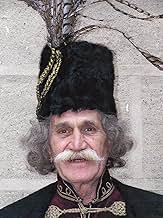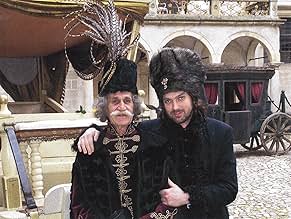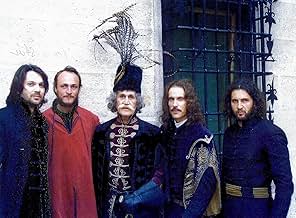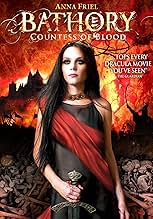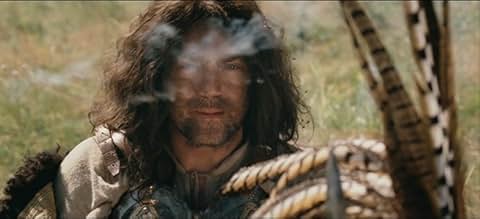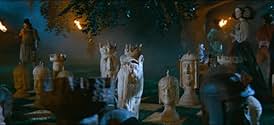ÉVALUATION IMDb
5,7/10
4,8 k
MA NOTE
Ajouter une intrigue dans votre langueWith an unquenchable thirst for blood, Countess Elizabeth Bathory was one of the most prolific serial killers in history.With an unquenchable thirst for blood, Countess Elizabeth Bathory was one of the most prolific serial killers in history.With an unquenchable thirst for blood, Countess Elizabeth Bathory was one of the most prolific serial killers in history.
- Prix
- 5 victoires et 4 nominations au total
Deana Horváthová
- Darvulia
- (as Deana Jakubisková-Horváthová)
Jaromír Nosek
- Miklós Zrínyi
- (as Míra Nosek)
Histoire
Le saviez-vous
- AnecdotesFamke Janssen was originally signed on for the part of Bathory, but for reasons unknown she backed out. Anna Friel read the script and fell in love with it and sent the director a letter convincing him to cast her. It was written in Slovak language, because her babysitter was from Slovakia and helped her writing it.
- ConnexionsReferenced in Vsechnopárty: Episode dated 24 June 2008 (2008)
Commentaire en vedette
Lavish, romanticized account of the life and times of 16th century Hungarian countess Erzsébet Bathory, history's most prolific serial killer...
BATHORY, a would-be epic with nice period detail, aspires to myth-buster status by painting the "Bloody Countess of Čachtice" as a victim of political chicanery in a male-dominated society but all it accomplishes is a "legend" of its own by white-washing history, facts be damned. Here, as a wealthy woman who's vast holdings could turn the tide in a power struggle between Catholics and Protestants as they fight off a Muslim invasion, Countess Bathory is more sinned against than sinning and framed for crimes she never committed. Yeah, right. Valentine Penrose & Alexander Trocchi's well-researched "The Bloody Countess: Atrocities Of Erzsébet Bathory", offers a significantly different account based on historical records:
"Descended from one of the most ancient aristocratic families of Europe, Erzsébet Bathory bore the psychotic aberrations of centuries of intermarriage. From adolescence she indulged in sadistic lesbian fantasies where only the spilling of a woman's blood could satisfy her urges. By middle age she had regressed to a mirror-fixated state of pathological necro-sadism involving witchcraft, torture, blood-drinking, cannibalism and, inevitably, wholesale slaughter. These years, at the latter end of the 16th century, witnessed a reign of cruelty unsurpassed in the annals of mass murder with the Countess' depredations on the virgin girls of the Carpathians leading to some 650 deaths. Her many castles were equipped with chambers where she would hideously torture and mutilate her victims, becoming a murder factory where hundreds of girls were killed and processed for the ultimate youth-giving ritual: the bath of blood..."
In Juraj Jakubisko's film, Erzsébet Bathory is depicted as an intelligent woman ahead of her time and a Protestant preyed upon by the Catholic Church as well as her late husband's covetous best friend although she still finds time for a passionate affair with the Italian painter Caravaggio (!) as her subjects try inventing spring-powered roller skates, phonographs, still photography, and primitive airplanes a la Leonardo Da Vinci. The tale, a de-fanged poison valentine to renaissance Hungary, is served up on a grand scale but twists the truth into a monumental mis-carriage of injustice that's recommended to revisionists only. What's next, JEFFREY DAHMER -THE MUSICAL?
BATHORY, a would-be epic with nice period detail, aspires to myth-buster status by painting the "Bloody Countess of Čachtice" as a victim of political chicanery in a male-dominated society but all it accomplishes is a "legend" of its own by white-washing history, facts be damned. Here, as a wealthy woman who's vast holdings could turn the tide in a power struggle between Catholics and Protestants as they fight off a Muslim invasion, Countess Bathory is more sinned against than sinning and framed for crimes she never committed. Yeah, right. Valentine Penrose & Alexander Trocchi's well-researched "The Bloody Countess: Atrocities Of Erzsébet Bathory", offers a significantly different account based on historical records:
"Descended from one of the most ancient aristocratic families of Europe, Erzsébet Bathory bore the psychotic aberrations of centuries of intermarriage. From adolescence she indulged in sadistic lesbian fantasies where only the spilling of a woman's blood could satisfy her urges. By middle age she had regressed to a mirror-fixated state of pathological necro-sadism involving witchcraft, torture, blood-drinking, cannibalism and, inevitably, wholesale slaughter. These years, at the latter end of the 16th century, witnessed a reign of cruelty unsurpassed in the annals of mass murder with the Countess' depredations on the virgin girls of the Carpathians leading to some 650 deaths. Her many castles were equipped with chambers where she would hideously torture and mutilate her victims, becoming a murder factory where hundreds of girls were killed and processed for the ultimate youth-giving ritual: the bath of blood..."
In Juraj Jakubisko's film, Erzsébet Bathory is depicted as an intelligent woman ahead of her time and a Protestant preyed upon by the Catholic Church as well as her late husband's covetous best friend although she still finds time for a passionate affair with the Italian painter Caravaggio (!) as her subjects try inventing spring-powered roller skates, phonographs, still photography, and primitive airplanes a la Leonardo Da Vinci. The tale, a de-fanged poison valentine to renaissance Hungary, is served up on a grand scale but twists the truth into a monumental mis-carriage of injustice that's recommended to revisionists only. What's next, JEFFREY DAHMER -THE MUSICAL?
- melvelvit-1
- 29 oct. 2010
- Lien permanent
Meilleurs choix
Connectez-vous pour évaluer et surveiller les recommandations personnalisées
- How long is Bathory: Countess of Blood?Propulsé par Alexa
Détails
Box-office
- Brut – à l'échelle mondiale
- 7 005 528 $ US
- Durée2 heures 21 minutes
- Couleur
- Mixage
- Rapport de forme
- 2.35 : 1
Contribuer à cette page
Suggérer une modification ou ajouter du contenu manquant

Lacune principale
By what name was Les Chroniques d'Erzebeth (2008) officially released in India in English?
Répondre


